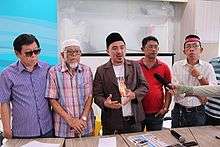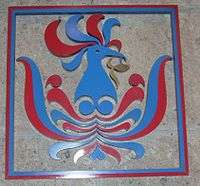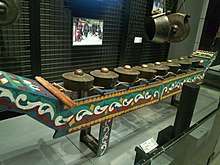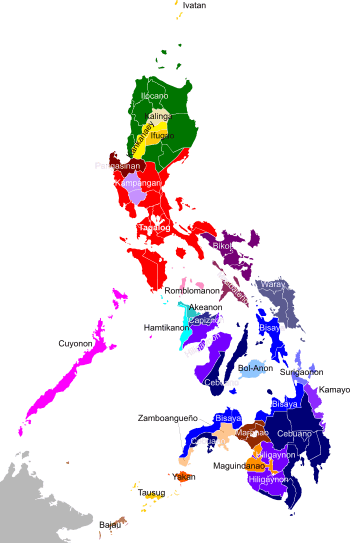Maranao people
The Maranao people (Maranao: ['mәranaw]; Filipino: Maranaw[3]), also spelled Meranao, Maranaw, and Mëranaw, is the term used by the Philippine government to refer to the southern tribe who are the "people of the lake", a predominantly-Muslim Lanao province region of the Philippine island of Mindanao. They are known for their artwork, weaving, wood, plastic and metal crafts and epic literature, the Darangen. They are ethnically and culturally closely related to the Iranun, and Maguindanao, all three groups being denoted as speaking Danao languages and giving name to the island of Mindanao.
 Modern-day Maranao sultans from Lanao. | |
| Total population | |
|---|---|
| 1,354,542[1] 1.47% of total population | |
| Regions with significant populations | |
| Bangsamoro, Zamboanga Peninsula, Northern Mindanao, SOCCSKSARGEN, Manila, Cebu in the Maranaos in Sabah, Maranaos in the US Maranaos in Middle East | |
| Languages | |
| Maranao, Chavacano, Cebuano, Tagalog, English, Malay | |
| Religion | |
| Predominantly Islam | |
| Related ethnic groups | |
| Iranun, Maguindanao, Tiruray Lumad, Tausug, Visayan, Malays other Moros, other Filipinos, other Austronesian peoples |
Etymology

The name "Maranao" (also spelled "Meranao" or "Meranaw") means "people of the lake" (lanaw or ranaw, archaic danaw, means "lake" in the Maranao language). This is in reference to Lake Lanao, the ancestral homelands of the Maranao people.[4]
The original endonym of the ancestral Maranao is believed to be "Iranun" or "Iranaoan".[5][6] This group later diverged, resulting in the modern Maguindanao and the Iranun people (whose names can also be translated to "people of the lake"),[7] while the ancestral Iranuns who stayed in Lake Lanao became known as the Maranao. These two ethnic groups, Iranun and Maranao, are still related to each other, share similar cultures and both speak a one language, they either call it Maranao or Iranun language which belongs to Danao languages.[5][6]
Culture
Maranao culture can be characterized by:
- Lake Lanao
- Sarimanok (Papanoka Mra and Mara-patik)
- Torogan, the highest form of a Maranao royal house, where the architecture used is the most aesthetic in the Philippines
- Darangen, a UNESCO Intangible cultural heritage
- Kirim, pre-Hispanic handwriting based from Arabic letters with 19 consonants and 7 vowels
- Singkil, a Philippine dance[8]
- Okir on wooden artifacts and brasswares
- Kapmorod and Kakhalilang with Sambolayang and Pasandalan a Morog and Marigay for Kazipa sa Manggis
- kaplagod (Racing horse)
The culture of the Maranaos is centered on Lake Lanao, the largest in Mindanao, and the second-largest and deepest lake in the Philippines. This lake is the subject of various myths and legends. It supports a major fishery, and powers the hydroelectric plant installed on it; the Agus River system generates 70% of the electricity used by the people of Mindanao. A commanding view of the lake is offered by Marawi City, the provincial capital.
Language
Maranao is an Austronesian language spoken by the Maranao people in the provinces of Lanao del Norte and Lanao del Sur.[9] Because of the mass influx of Cebuano migrants to Mindanao, many Maranaos are also fluent in Cebuano.
Arabic, a Central Semitic language, is spoken by a minority of the Moro people, as it is the liturgical language of Islam. Most Maranaos, however, do not know Arabic beyond its religious use.
Art

Sarimanok, Papanoka "Mra" or "Mara patik" is a legendary bird of the Maranao that is a ubiquitous symbol of their art. It is depicted as a Hoodhud (Arabic) with colorful wings and feathered tail, holding a fish on its beak or talons. The head of Sarimanok is like the head of a Hoopoe (Balalatoc in maranaw) and is profusely decorated with scroll, leaf and spiral motifs (okir). It is a symbol of good fortune.[10][11]
The Maranao have also developed their own adaptation of the Ramayana epic, the Maharadia Lawana. They also have a traditional dance, the Singkil, which was based on another local Ramayana adaptation, the Darangen.
Music

Maranao kulintang music is a type of a gong music. Sarunaayfis also found among both Muslim and non-Muslim groups of the Southern Philippines. Kobbing is a Maranao instrument and Biyula is another popular Instrument. Biyula is a string instrument. In 2005, the Darangen Epic of the Maranao people of Lake Lanao was selected by UNESCO as a Masterpiece of the Oral and Intangible Heritage of Humanity.
Cuisine
Maranao cuisine is quite spicy, with spices mixed up. Traditionally cultivated spices, locally known as palapa (Bontang, native product in Gandamatu) are a common condiment.[12] It is made of stewed scallion bulbs or “sakurab” in Maranao. Thinly sliced scallion bulbs and ginger are caramelized by slow cooking and mixed with chilies and coconut oil.[13]
Dishes are intertwined with important cultural rituals across all aspects of Maranao culture: from birth to death.![14]
Social structure
Traditionally, the Maranao society is divided into two strata. Namely, Mapiyatao (Pure) and Kasilidan (Mixed blood). Kasilidan is further subdivided into categories which are as follows; Sarowang (Non-Maranao), Balbal (Beast), Dagamot (Sorcerer/Sorceress) and Bisaya (Slave). The Mapiyatao are those natives who are entitled to ascend to thrones and has a pure royal bloodline. On the other hand, the Kasilidan are those natives who are suspected of mixed bloodline. However, due to the changes brought by time, these social strata are beginning to decline due to the rise of wealth of each and every Maranao families.
Demographics

Maranaos number 1,354,542 in 2010, representing 1.47% of the population.[15] Along with the Iranun and Maguindanao, the Maranao are one of three, related, indigenous groups native to Mindanao. These groups share genes, linguistic and cultural ties to non-Muslim Lumad groups such as the Tiruray or Subanon. Maranao royals have varied infusions of Arab, Indian, Malay, and Chinese ancestry.
History
As with other Indigenous and Mindanao Lumads, during the nominal occupation of the Philippines by the Spanish, and later the American and the Japanese, the Maranaos had tribal leaders whom they called Datu. In the 14th century, upon the arrival of Islam, they developed into a kingdom with a Sultan due to the influence of Muslim missionaries.
Notable Maranaos
- Mamintal A.J. Tamano was a Filipino statesman and a former Senator of the Philippines.
- Adel Tamano is a Filipino educator, lawyer and former politician.
- Ansaruddin Alonto Adiong is a Filipino politician and current acting governor of the Autonomous Region in Muslim Mindanao (ARMM).
- Mamintal M. Adiong Sr. was a long-time Filipino politician, serving as Governor of Lanao del Sur from 2001 until his death from cardiac arrest.
- Mamintal Alonto Adiong Jr. is the present governor of the Province of Lanao del Sur.
- Abul Khayr Alonto is a Filipino businessman and lawyer.
- Dimasangcay Pundato is a former Moro revolutionary leader and current undersecretary of the Office of the Presidential Adviser on the Peace Process
- Datu Yusoph Boyog Mama is a Filipino philanthropist and composer
- Samira Gutoc-Tomawis is a Filipino civic leader, journalist, environment and women's rights advocate, and legislator[1] who has served as member of the Regional Legislative Assembly of the Autonomous Region of Muslim Mindanao and a member of the Bangsamoro Transition Commission which was tasked to draft the Bangsamoro Basic Law.
- Moh Saaduddin was a journalist, peace advocates, and served as a provincial information officer of the province of Maguindanao.
- Imelda Dimaporo is a politician and current governor of Lanao Del Norte.
- Princess Fatimah Parahiman is a first female Maranao lawyer who earned the top 2 with score 89.5230% in Philippine BAR examination 2019.[16]
Notes and references
- "2010 Census of Population and Housing, Report No. 2A: Demographic and Housing Characteristics (Non-Sample Variables) - Philippines" (PDF). Philippine Statistics Authority. Retrieved 19 May 2020.
- Admin. "About Us". FEMAS. Archived from the original on April 18, 2011. Retrieved October 21, 2010.
- Archived October 12, 2013, at the Wayback Machine
- Hamilton, Roy W. (1998). From the rainbow's varied hue: textiles of the southern Philippines. UCLA Fowler Museum of Cultural History. p. 135. ISBN 9780930741648.
- Lobel, Jason William; Riwarung, Labi Hadji Sarip (2009). "Maranao Revisited: An Overlooked Consonant Contrast and its Implications for Lexicography and Grammar". Oceanic Linguistics. 48 (2): 403–438. doi:10.1353/ol.0.0040. JSTOR 40783537.
- Baradas, David B. (1968). "Some Implications of the Okir Motif in Lanao and Sulu Art" (PDF). Asian Studies. 6 (2): 129–168.
- Campbell, Gwyn (2018). Bondage and the Environment in the Indian Ocean World. Springer. p. 84. ISBN 9783319700281.
- https://www.youtube.com/watch?v=GzhoWsVElXo https://www.youtube.com/watch?v=c6JVSMSIYn4
- "Welcome". Learn Maranao Language Website. Archived from the original on October 6, 2010. Retrieved October 21, 2010.
- "Sari-Manok". Philippines Art and Culture. Retrieved October 21, 2010.
- Madale, Nagasura T. (2010-02-07). "Recipe in the Life of the Maranao By: Nagasura T. Madale, PhD. -Part 2". Kalopindo. Aratawata Website. Archived from the original on July 14, 2011. Retrieved October 22, 2010.
- Umagang Kay Ganda (2013-07-09). "Recipe: Maranao dish Chicken Piaparan". ABS-CBN Corporation Website. Retrieved July 9, 2013.
- Rosauro, Ryan (2010-10-17). "Munai spice may be way out of war for conflict areas". Inquirer Website. Archived from the original on October 23, 2010. Retrieved October 22, 2010.
- Madale, Nagasura T. (2010-02-06). "Recipe in the Life of the Maranao By: Nagasura T. Madale, PhD. -Part 1". Kalopindo. Aratawata Website. Archived from the original on July 14, 2011. Retrieved October 21, 2010.
- "2010 Census of Population and Housing, Report No. 2A: Demographic and Housing Characteristics (Non-Sample Variables) - Philippines" (PDF). Philippine Statistics Authority. Retrieved 19 May 2020.
- Macabalang, Ali. "Maranao is 1st Muslim lady bar topnotcher". Manila Bulletin. Retrieved May 1, 2020.
External links
- Maranao
- Maranao Online
- Ranao, Ranao (Lake) terms for Lanao del Sur.